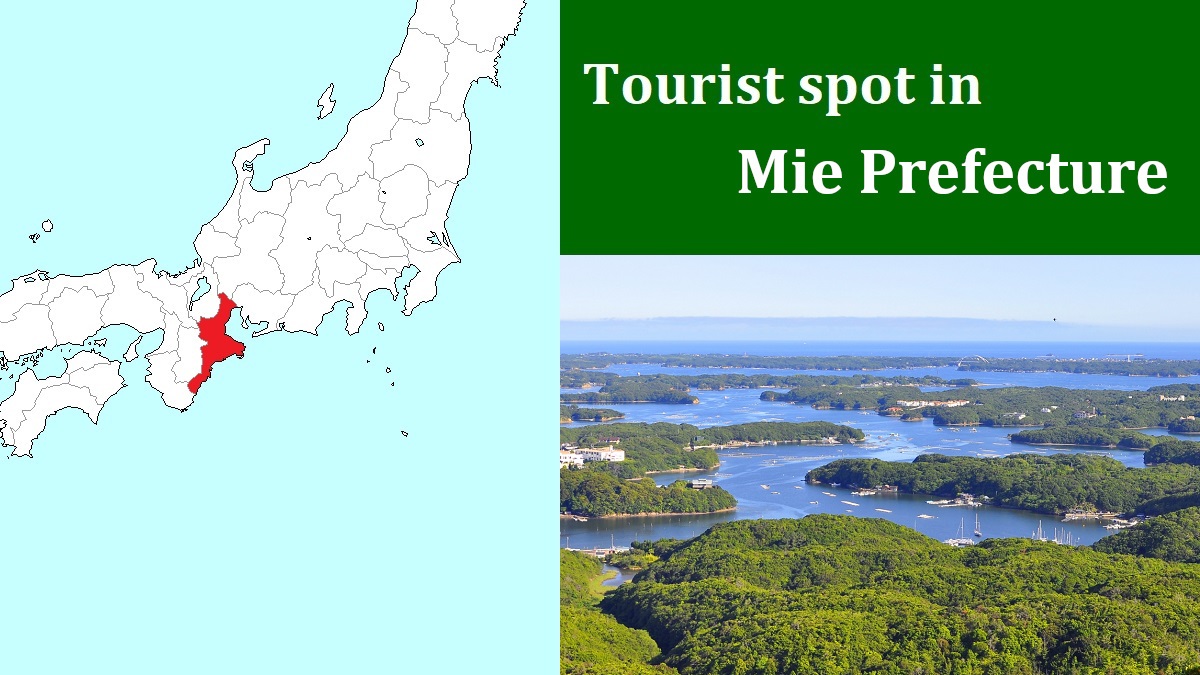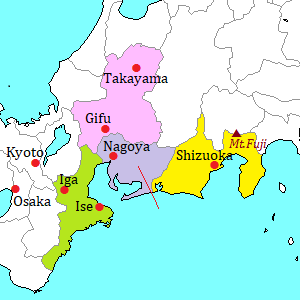Ise Shrine [伊勢神宮]
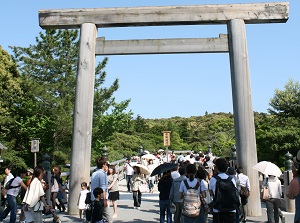
Entrance of Naiku
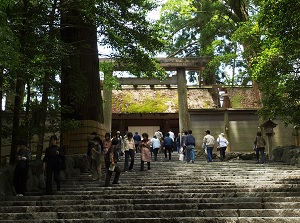
Main shrine of Naiku
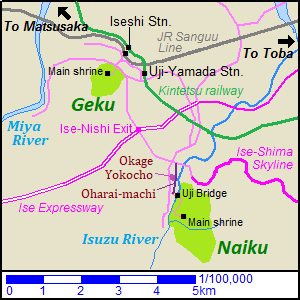
Ise Shrine ("Ise Jingû" in Japanese) is the Shinto shrine in Ise city.
It is the highest rank of the 80,000 Shinto shrines in Japan.
So, it is treated as a special shrine.
According to Japanese myth, Yamato-hime-no-mikoto, a daughter of Emperor Suinin (the 11th Emperor), traveled around western Japan.
Then, she reached Ise area, and she founded this shrine in 4 B.C.
And she enshrined Amaterasu-Oomikami who was the sun goddess and her ancestor.
In ancient times, only Emperor, Empress and Crown Prince were allowed to visit, because this shrine was very sacred.
In the middle ages, samurais visited here.
Since the 17th century, common people became able to visit here.
Especially, visiting Ise Shrine was the lifelong dream of citizens in Edo Period (1603-1868).
Now, more than 5 million people visit here every year.
In April 2019, Their Majesties the Emperor and Empress visited this shrine for reporting their abdication to the gods.
The Prime Minister of Japan has visited here on January 4th every year since 1967, as their first work of the new year.
In addition, when the 42nd G7 Summit was held in Ise-Shima area in 2016, Prime Minister Abe Shinzo invited all leaders of G7 to this shrine.
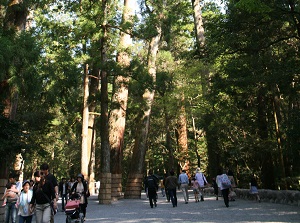
Approach in Naiku
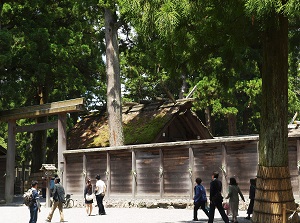
Main shrine of Geku
Ise Shrine has two main shrines.
They are Naikû (内宮) and Gekû (外宮).
And Ise Shrine has 125 branch shrines in total, in and around Ise city.
Ise Shrine advises that you should visit Geku first then visit Naiku.
But the distance between both shrines is about 4 km.
So many people who don't have much time visit only Naikuu.
As a result, Naiku is always crowded.
Despite its long history, all buildings in this shrine is not old.
Because, all buildings are rebuilt every 20 years.
This rebuiding has been done since 690.
This rebuilding is the big event of the shrine, and about various 30 ceremonies are held for 8 years until the completion.
The significance of rebuilding is mainly to keep the clean shrine and to inherit the technology of traditional architecture.
This event is called Shikinen-Sengû as a whole.
The last event was done as the 62nd Shikinen-Sengu from 2005 to 2013.
The 63rd Shikinen-Sengu will be completed in 2033.
Main railway station is Uji-Yamada (宇治山田) of Kintetsu railway.
There is the terminal of route bus and taxi.
Iseshi station is near Geku, and the trains of both Kintetsu railway and JR stop at this station.
Geku (外宮)
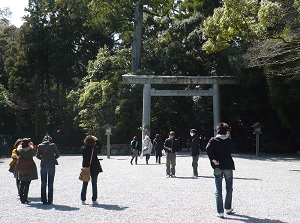
Entrance of Geku
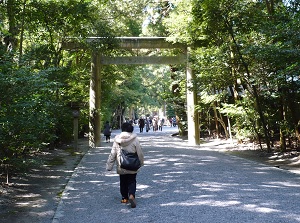
Approach to main shrine in Geku
Geku is one of the main shrines of Ise Jingu.
"U" in the word is pronounced long, so it is read as "Gekû".
It is in the center of Ise city, and is located about 500 meters southwest of Iseshi station of JR or Kintetsu railway.
It is said that this shrine was founded in 478.
The formal name of the shrine is Toyouke-Daijingu (豊受大神宮), and "Toyouke-Oomikami" who is the goddess of food is enshrined.
The main precinct is about 1 km from east to west and about 0.4 km from north to south, and there is a low hill named "Takakurayama" to the south of the shrine.
Several shrines are surrounded with forest and some ponds and moats are dotted around the precinct.
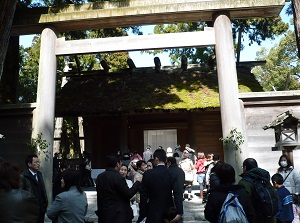
Main shrine of Geku
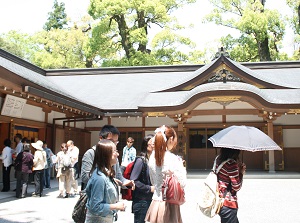
A hall in Geku
After we walk on the approach about 300 meters long from the entrance, we reach the central shrine.
Visitors worship at the shrine.
It is surrounded by a wall, and you can't take photos in the shrine.
Naiku (内宮)
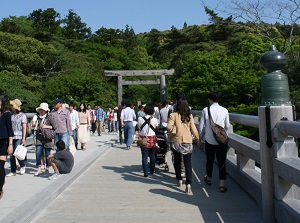
Uji-bashi in Naiku
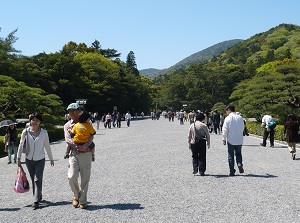
Wide approach along the garden in Naiku
Naiku is also one of the main shrines of Ise Jingu.
"U" in the word is pronounced long, so it is read as "Naikû".
It is located about 4 km south of Geku.
Many people visit this shrine as Ise Shrine.
Of course, this is the original shrine of Ise Jingu.
The formal name of the shrine is Koutai-Jingu (皇大神宮).
It enshrines "Amaterasu-Oomikami".
She was a sun goddess.
Her father was Izanagi and her mother was Izanami, and they created the land of Japan in Japanese myth.
It is said that they were the an ancestors of current Imperial family of Japan.
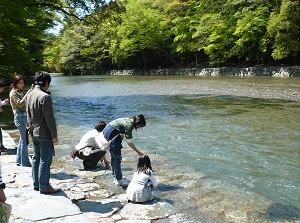
Isuzu River in Naiku
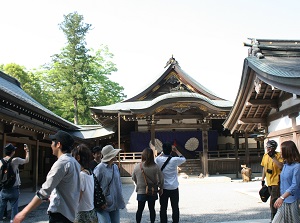
A hall along the approach in Naiku
The main precinct is about 0.7 km from north to south about about 0.3 km from east to west.
On the west side, Isuzu River (五十鈴川)
A vast forest expands around the precinct and Isuzu River.
First, after you walk through under a big Torii gate, you cross Uji Bridge (宇治橋) across Isuzu River.
So, you have entered the sacred area.
You walk on the wide graveled approach along the garden for about 300 meters.
There is a Chozuya (water ablution pavilion).
Please wash your hands.
After you pass through the second torii gate, you can go to the riverside of Isuzu River.
Isuzu River is the sacred river, so please dip your hands in the water.
Then, you walk on the approach in the forest for about 400 meters.
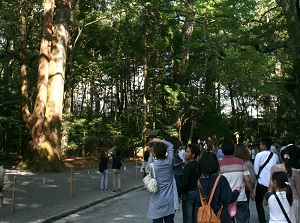
Forest around the approach to main shrine
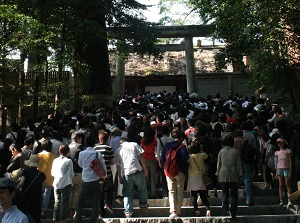
Main shrine of Naiku
You reach the stone stairs.
The central shrine is on the top of the stairs with 25 or 30 steps.
Visitors worship at the shrine.
It is surrounded by a wall, and you can't take photos in the shrine.
There is a large open space next the central shrine.
New buildings of the shrine will be built on the space in the next "Shikinen-sengu" event (in 2033), then the central shrine will be moved to the new buildings.
Oharai-machi (おはらい町)
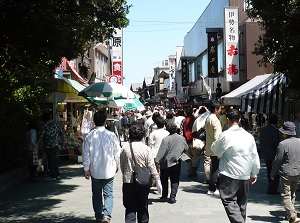
Oharai-machi
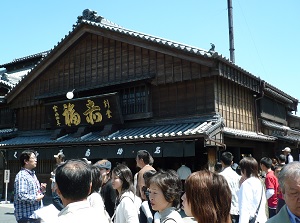
Akafuku shop in Oharai-machi
Oharai-machi is the shrine town since old times.
It is always full with the people after worshipping.
Many souvenir shops, restaurants and cafes are along a street.
It is the street about 800 meters long from near Uji Bridge.
We can find the restaurants serving Ise Udon which is the local noodle in Ise city.
And there is the popular tea shop of Akafuku at the middle of the street.
We can taste Akafuku, very popular sweet confection in Ise.
Okage-yokocho (おかげ横丁)
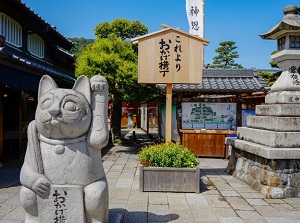
Entrance of Okage-yokocho
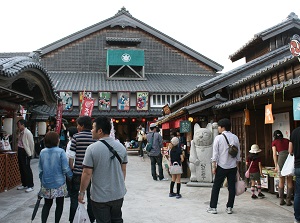
Shops in Okage-yokocho
Okage-yokocho is the new shrine town constructed in 1993.
The town is around the tea shop of Akafuku.
The buildings and houses were built like the ones in the 17th to 19th centuries.
There are also many restaurants and shops, and museums and theaters are also added in the town.
How to get here
By limited express of Kintetsu railway, to Uji-Yamada station, about 1 hour and 25 minutes from Nagoya, about 2 hours and 10 minutes from Kyoto, about 1 hour and 45 to 50 minutes from Nanba or Osaka-Uehonmachi.
By route bus, from Uji-Yamada station, about 5 minutes to Geku, about 15 minutes to Naiku.

